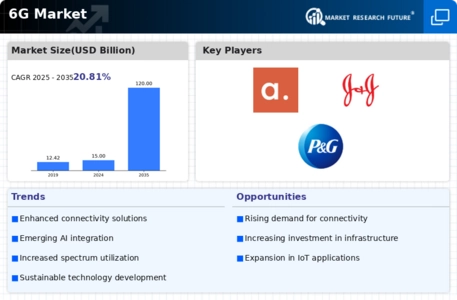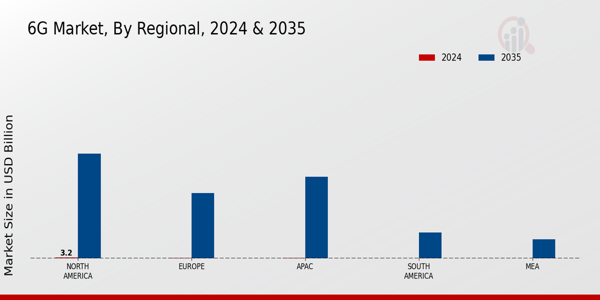Market Growth Projections
The Global 6G Market Industry is projected to experience robust growth over the coming years, with a compound annual growth rate of 20.81% anticipated from 2025 to 2035. This growth trajectory is indicative of the increasing investment in research and development, as well as the rapid adoption of 6G technologies across various sectors. By 2035, the market is expected to reach 120 USD Billion, driven by advancements in telecommunications infrastructure and the emergence of new applications. The convergence of technologies such as AI, IoT, and big data analytics is likely to further accelerate this growth, positioning the Global 6G Market Industry as a key player in the future of global communications.
Government Initiatives and Funding
Government initiatives and funding play a crucial role in the development of the Global 6G Market Industry. Many nations are recognizing the strategic importance of advanced telecommunications and are investing in research and development to foster innovation. Public-private partnerships are emerging to accelerate the deployment of 6G technologies, with governments providing financial support for pilot projects and infrastructure upgrades. These initiatives not only stimulate market growth but also ensure that countries remain competitive in the global technology landscape. As a result, the Global 6G Market Industry is likely to benefit from sustained investment and policy support, which will be vital for its long-term success.
Rising Demand for High-Speed Connectivity
The Global 6G Market Industry is witnessing a surge in demand for high-speed connectivity, driven by the increasing reliance on digital services and applications. As industries evolve, the need for faster data transmission and lower latency becomes paramount. In 2024, the market is projected to reach 15 USD Billion, reflecting the urgency for enhanced communication technologies. This demand is further fueled by the proliferation of IoT devices and smart technologies, which require seamless connectivity. The anticipated growth in user expectations for real-time data access and responsiveness indicates that the Global 6G Market Industry is poised for substantial expansion.
Emergence of New Applications and Use Cases
The Global 6G Market Industry is characterized by the emergence of innovative applications and use cases that leverage advanced connectivity. Technologies such as augmented reality, virtual reality, and autonomous systems are anticipated to thrive in a 6G environment, where ultra-reliable low-latency communication is a standard. These applications not only enhance user experiences but also create new business opportunities across various sectors, including healthcare, transportation, and entertainment. As these technologies mature, they are likely to drive significant investment in the Global 6G Market Industry, further propelling its growth. The potential for new revenue streams indicates a dynamic future for the industry.
Advancements in Telecommunications Infrastructure
The Global 6G Market Industry benefits from ongoing advancements in telecommunications infrastructure, which are essential for supporting next-generation networks. As countries invest in upgrading their existing networks, the transition to 6G technology becomes increasingly feasible. Governments are allocating resources to enhance fiber optic networks and satellite communications, which are critical for achieving the high bandwidth and low latency that 6G promises. This infrastructure development is expected to facilitate a smoother rollout of 6G services, contributing to the market's growth trajectory. By 2035, the Global 6G Market Industry is projected to reach 120 USD Billion, underscoring the importance of robust infrastructure.
Growing Focus on Sustainability and Energy Efficiency
The Global 6G Market Industry is increasingly focused on sustainability and energy efficiency, reflecting a broader trend towards environmentally conscious technology development. As the demand for data and connectivity rises, the energy consumption of telecommunications networks becomes a critical concern. 6G technology aims to address this challenge by incorporating energy-efficient designs and sustainable practices. Innovations such as advanced antenna technologies and network optimization techniques are expected to reduce the carbon footprint of telecommunications. This focus on sustainability not only aligns with global environmental goals but also enhances the appeal of the Global 6G Market Industry to investors and consumers alike.














